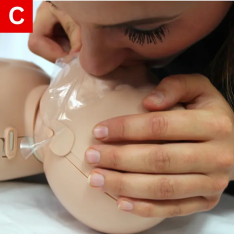- Airway Management
- Mouth-to-Mouth Rescue Breathing
- Rescue Breathing
Mouth-to-Mouth Rescue Breathing
When a pocket mask or bag-mask is not available, it may be necessary to give mouth-to-mouth breaths during CPR. Mouth-to-mouth breathing is very effective in delivering oxygen into the person’s lungs without putting the rescuer at a high level of risk. The rescuer’s exhaled air contains approximately 17% oxygen and 4% carbon dioxide. This is in contrast to the 100% oxygen available with ventilation with 100% high flow oxygen and the 21% oxygen that is available in room air that we breathe.




ADULTS AND OLDER CHILDREN MOUTH-TO-MOUTH
Do not give breaths too rapidly or too forcefully. Doing this may cause air to be forced into the stomach, resulting in distention and less room for lung expansion. It may also cause vomiting.
To deliver mouth-to-mouth breaths, do the following:
- Open the airway using the head-tilt/chin-lift maneuver (Figure 13a).
- Pinch the person’s nose closed with your hand on the person’s head (Figure 13b).
- Create a seal when using your lips to surround the person’s mouth (Figure 13c).
- Blow into the person’s mouth for one full second and watch for chest to rise (Figure 13d) Tilt the victim’s head further back if the chest does not rise.
- Give an additional breath for over one second.
- If you cannot see the chest rise in two breaths, continue giving chest compressions.



INFANTS MOUTH-TO-MOUTH/NOSE
When performing rescue breathing on an infant, the rescuer should cover the infant’s mouth and nose when possible and do the following:
- Open the airway using the head-tilt/chin-lift maneuver. Be sure not to hyper-extend the neck. Aim for a neutral position (Figure 14a).
- Create a seal using your lips to surround the infant’s nose and mouth (Figure 14b).
- Gently blow into the infant’s nose and mouth for one second (Figure 14c). Keep in mind that an infant’s lungs are smaller than an adult’s and need a smaller volume of air. Watch for the infant’s chest to rise. If you cannot see the chest rise, re-adjust the tilt of their head.
- Give an additional breath and watch for the infant’s chest to rise. If unable to cover both mouth and nose entirely with your mouth, use the following method for rescue breathing:
- Open the airway using the head-tilt/chin-lift maneuver.
- Pinch the infant’s nose closed.
- Create a seal using your lips to surround the infant’s mouth.
- Gently blow into the infant’s mouth for one second.
- Give an additional breath and watch for the chest to rise.
